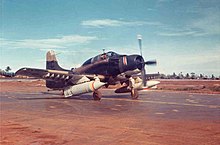Thermobaric weapon
They are, however, considerably more effective when used in enclosed spaces such as tunnels, buildings, and non-hermetically sealed field fortifications (foxholes, covered slit trenches, bunkers).Accidental unconfined vapor cloud explosions now happen most often in partially or completely empty oil tankers, refinery tanks, and vessels, such as the Buncefield fire in the United Kingdom in 2005, where the blast wave woke people 150 kilometres (93 mi) from its centre.The continual combustion of the outer layer of fuel molecules, as they come into contact with the air, generates added heat which maintains the temperature of the interior of the fireball, and thus sustains the detonation.[19] In confinement, a series of reflective shock waves is generated,[20][21] which maintain the fireball and can extend its duration to between 10 and 50 ms as exothermic recombination reactions occur.[24] A Human Rights Watch report of 1 February 2000[25] quotes a study made by the US Defense Intelligence Agency: The [blast] kill mechanism against living targets is unique—and unpleasant. ...Those at the fringe are likely to suffer many internal, invisible injuries, including burst eardrums and crushed inner ear organs, severe concussions, ruptured lungs and internal organs, and possibly blindness.Another Defense Intelligence Agency document speculates that, because the "shock and pressure waves cause minimal damage to brain tissue ... it is possible that victims of FAEs are not rendered unconscious by the blast, but instead suffer for several seconds or minutes while they suffocate".[26] The first attempts occurred during the First World War when incendiary shells (in German 'Brandgranate') used a slow but intense burning material, such as tar impregnated tissue and gunpowder dust.[27] In World War II, the German Wehrmacht attempted to develop a vacuum bomb,[28] under the direction of the Austrian physicist Mario Zippermayr.[32] Current American FAE munitions include the following: The XM1060 40-mm grenade is a small-arms thermobaric device, which was fielded by US forces in Afghanistan in 2002, and proved to be popular against targets in enclosed spaces, such as caves.The RPO-M, for instance, has a thermobaric warhead with a TNT equivalence of 5.5 kg (12 lb) and destructive capabilities similar to a 152 mm (6 in) high-explosive fragmentation artillery shell.The Kornet has since been upgraded to the Kornet-EM, and its thermobaric variant has a maximum range of 10 km (6 mi) and has a TNT equivalence of 7 kg (15 lb).[57] In 1996, the People's Liberation Army (PLA) began development of the PF-97 [zh], a portable thermobaric rocket launcher, based on the Soviet RPO-A Shmel.Like the US weapon, the Trocano was designed to be pallet-loaded into a C-130 Hercules aircraft, and deployed using a parachute to drag it from the C-130's cargo bay and separate the bomb from its pallet.[61] In 2009, the British Ministry of Defence (MoD) acknowledged that Army Air Corps (AAC) AgustaWestland Apaches had used AGM-114 Hellfire missiles purchased from the United States against Taliban forces in Afghanistan.MoD officials told Guardian journalist Richard Norton-Taylor that the missiles were "particularly designed to take down structures and kill everyone in the buildings", as AAC AgustaWestland Apaches were previously equipped with weapon systems deemed ineffective to combat the Taliban."[62] In 2018, the MoD accidentally divulged the details of General Atomics MQ-9 Reapers utilised by the Royal Air Force (RAF) during the Syrian civil war, which revealed that the drones were equipped with AGM-114 Hellfire missiles.This HESH round packs thermobaric explosives into the tank shells to increase the effectiveness against enemy bunkers and light armoured vehicles.The grenades, of approximately 600 grams, "create a two second fire cloud with a volume of not less than 13 m³, inside of which the temperature reaches 2,500 degrees[clarification needed].On 3 March 2002, a single 2,000 lb (910 kg) laser guided thermobaric bomb was used by the United States Air Force against cave complexes in which Al-Qaeda and Taliban fighters had taken refuge in the Gardez region of Afghanistan.[102] A United Nations panel of human rights investigators reported that the Syrian government had used thermobaric bombs against the rebellious town of Al-Qusayr in March 2013.[106][107] In March 2023 soldiers from the 59th Motorised Brigade of Ukraine showed off the destruction of a derelict Russian infantry fighting vehicle by a thermobaric RGT-27S2 hand grenade delivered by Mavic 3 drone.[109] The explosive used by the bombers in the US 1993 World Trade Center bombing incorporated the FAE principle by using three tanks of bottled hydrogen gas to enhance the blast.[110][111] Jemaah Islamiyah bombers used a shock-dispersed solid fuel charge,[112] based on the thermobaric principle,[113] to attack the Sari nightclub during the 2002 Bali bombings.This precision aspect serves to provide humanitarian advantages by potentially minimizing collateral damage and also lessens the amount of munitions needed to effectively engage with the chosen military goals.Nonetheless, authors holding this view recommend that the use of thermobaric weapons in populated areas should be minimised due to their wide-area impact and multiple harm mechanisms.




USS McNultyexplosivedispersing an aerosol cloud of gas, liquid or powdered explosivepressureradiant heatconventional explosivesoxidiserfield fortificationstrenchesbunkersblast waveoxidationblast frontdust explosionsflour millsBuncefield firenanofuelslimits of flammabilityrarefactionatmospheric oxygenantipersonnelHuman Rights WatchDefense Intelligence Agencypressure waveruptures the lungsdeflagratesethylene oxidepropylene oxidechemical agentsCentral Intelligence Agencyinternalburst eardrumsinner earconcussionsruptured lungs and internal organsblindnessbrain tissueFirst World WarWorld War IIWehrmachtMario ZippermayrOperation CobraNakhon PhanomThailandVietnam WarCBU-55CBU-72AGM-114 Hellfire2003 invasion of IraqSMAW-NEMk 153 SMAWAGM-114N Hellfire IIRPO-A ShmelSoviet UnionRussian armed forcesrocket propelled grenadegrenade launcherclose combatTNT equivalencehigh-explosive fragmentationRShG-1RShG-2tandem-chargehigh-explosive anti-tankreinforced concreterolled homogeneous armoursemi-automatic command to line of sightactive radar homing9M123 Khrizantema9M133 Kornet9K115-2 Metis-Manti-tank missilesBM-30 SmerchIskander-Mtheatre ballistic missileRussian Air ForceS-8 rocketKAB-500KRGLONASS9M120 Ataka-V9K114 ShturmFather of All BombsMassive Ordnance Air BlastbackronymMinistry of DefenceUnión Explosivos Río TintoSpanish Air and Space ForcePeople's Liberation ArmyInstitute of Aeronautics and SpaceC-130 HerculesBritish Ministry of DefenceArmy Air CorpsAgustaWestland ApachesTalibanin AfghanistanGuardianRichard Norton-Taylorrules of engagementcockpitGeneral Atomics MQ-9 ReapersRoyal Air ForceSyrian civil warfreedom of information requesthigh-explosive squash headIndian Ministry of DefenceArmament Research and Development EstablishmentArjun MBTUkroboronpromOleksandr TurchynovRusso-Ukrainian WarUnited NationsUnited Nations Institute for Disarmament ResearchOperation Desert StormCBU-72sUnited States Marine Corpspsychological weaponUS militarylaser guidedUnited States Air ForceAl-QaedaGardezFirst Battle of FallujahSecond Battle of Fallujah2003 in IraqSino-Soviet border conflictTOS-1 system